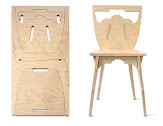Copyright © Françoise Herrmann
In France, a vast “underground” volunteer network
of makers designed, fabricated, and donated several hundred thousand face shields
(Leloup, April 23, 2020). They fulfilled orders locally, throughout France, for
both medical personnel at hospitals and nursing homes, and other frontline
workers, such as pharmacists, private healthcare practitioners, bakers, grocery
store personnel, and police officers.
Using 3D printers for the headband and a
sheet of transparent plastic, alternatively a laser cutting machine for visors and headbands made of plastic sheets only, more than 250,000 face shields were donated, with many more requests queued for the on-going re-opening of
the economy. According to O1Net, some 300 existing maker
labs (part of the Fablabs network in France), and a few thousand more independent makers, were mobilized.
New maker labs and initiatives also sprung to
action, specifically in response to the COVIID 19 pandemic shortages of PPE
(Personal Protection Equipment). For example, new maker labs such as Visière Solidaire, MakerscovidParis, Covid3D, Makers contre le Covid, were created, as well as a new
program, the OPEN COVID 19 Initiative, launched using the JOGL
platform, A multi-faceted program, designed to bring together COVID 19-related projects, resources (including microcredit), volunteers, partners, and enablers.
A new platform www.covid3D.fr
was also developed and launched, almost overnight, bringing together (per the interface counters) 9980 volunteer makers, who donated 205882 face shields to individuals requesting, from all regions in France, as
well as French-speaking countries (1). The advantage of the platform developed was that no middle person existed between makers and the individuals requesting face shields. The
software handled the matching of production capacity with requests, according to
location, in a few easy steps. In other words, makers specified their production
capacity, while those individuals requesting face shields specified the quantities they needed.
Once a match occurred, phone numbers were unmasked and both parties worked out the
details for safe delivery, usually in person, and locally, in compliance with distancing rules. The platform also welcomed high-in-demand donations of plastic sheets, and 3D
ink for the headbands.
Finally, the Fabricommuns.org platform was also created, where the most comprehensive information was posted to provide liability guidelines to face shield makers. Legal information, considering donation vs. sale of PPE, and recent (DGE April 23, 2020; DGE April 30, 2020 ) simplified
emergency standards that the French administration developed for donated face shields. For example, guidelines and explanations were provided (Villeret, 2020), in regards to the following (and much more):
- COVID 19 marking, valid through August 31, 2020, vs. CE certification
marking, as a form of simplified standardization
- labeling designed to inform
users that the face shields protect against splashes and droplets. In other words, labeling
that in fact serves to clarify the differences between face shields and face
masks, since face masks are designed to
protect against inhalation of aerosols, whereas face shields are designed to
protect against liquid splashes and droplets. Consequently, face shields are
designed for use together with face masks, since they do not prevent absorption of
aerosols via the upper respiratory tract. Most importantly, face shields should
never be used to replace face masks.
- inserts specifying recommended sterilization procedures for the
face shields, since safety precautions, taken during the maker process, are not intended to result in a sterile product for healthcare professionals.
In terms of the actual designs of the face shields, several open-source, 3D, and laser-cut only, designs were downloaded by the French makers (e.g., Maker Models). The designs were mostly un-validated, due to the emergency situation, but certainly updated with feedback
from medical personnel, and other frontline workers, benefitting from the
donations.
Below, one of the open-source 3D face shield designs used, produced and donated by the French Fablab makers. This 3D model is called Visière Solidaire. The design comprises several parts:
- 3D-printed headband
- three 3D-printed clips, used to secure the visor onto the headband
- clear plastic visor, and
- two elastic bands, used to fit the headband and visor on the user's head.
Two STL (3D stereolithographic) files of the headband and clips are included in the mosaic below, together with Images of the printed parts, and assembled face shield product.
In France, according to 01Net, if there are lessons to be learned from the extraordinary volunteer maker response to the
COVID19 emergency PPE shortfall, it is that perceptions of maker activity have
changed. From prototype specialists, repair technicians and small volume
manufacturers, makers were able to organize into a full-blown procurement network of organized producers and
distributors. An incredibly efficient, distributed supply chain was created, able to fulfill
orders everywhere, until shuttered industrial facilities could adapt, re-open,
and take charge.
_____________
Note (1) A notice is now posted on the www.covid3D.fr platform, indicating that, the www.covid3D.fr
platform has been permanently terminated. The abrupt termination apparently arises in a stressful effort to
protect makers and platform designers from possible lawsuits. Lawsuits that might arise in
connection with any perceived absence of conformity with the new (adapted) standards (DGE - April 30, 2020) that were developed for COVID 19 donated face shields. References
01Net (April 22, 2020) L’incroyable mobilisation des makers pour fournir du matériel de protection aux soignants. https://www.01net.com/actualites/l-incroyable-mobilisation-des-makers-pour-fournir-du-materiel-de-protection-aux-soignants-1894999.html
Covid3D: https://www.covid3d.fr/
DGE - April 23, 2020: https://www.entreprises.gouv.fr/files/files/home/2020_63.pdf
DGE - April 30, 2020: https://www.entreprises.gouv.fr/files/files/note-d-information-visiere-30-avril-020.pdf
Fabricommuns: https://fabricommuns.org/
Leloup, D. (April 23, 2020) Les visières de protection imprimées 3D: Une réponse des makers à la crise – Le Monde. https://www.lemonde.fr/pixels/article/2020/04/23/les-visieres-imprimees-en-3d-une-reponse-des-makers-a-la-crise-sanitaire_6037538_4408996.html
Maker models (face shields): https://docs.google.com/spreadsheets/d/1pqexuyiwQwJ9rH8impv5KVcy5DEidWMJMB4vQYGqkks/edit#gid=1781920509
MakerZine #1: https://online.pubhtml5.com/krtg/ufax/?fbclid=IwAR0wLxwARv9XT_VGxdZg0OWI-Z-3p_WnrHW8rR5I13XbEkOsq1IIgW6f1XE
MakersCovidParis: https://makerscovid.paris/
Makers contre le Covid: https://www.facebook.com/groups/1120744844933688/
Open COVID-19 Initiative: https://app.jogl.io/program/opencovid19
Réseau francais des FabLabs (RFFLabs): http://www.fablab.fr/
Villeret, C. (May 12, 2020) Réalisation
de visières de protection: Nouvelles normes et loi impactant les makers. https://fabricommuns.org/2020/05/12/realisation-de-visieres-de-protection-nouvelles-normes-et-loi-impactant-les-makers/
Visière Solidaire: https://visieresolidaire.org/fr/










